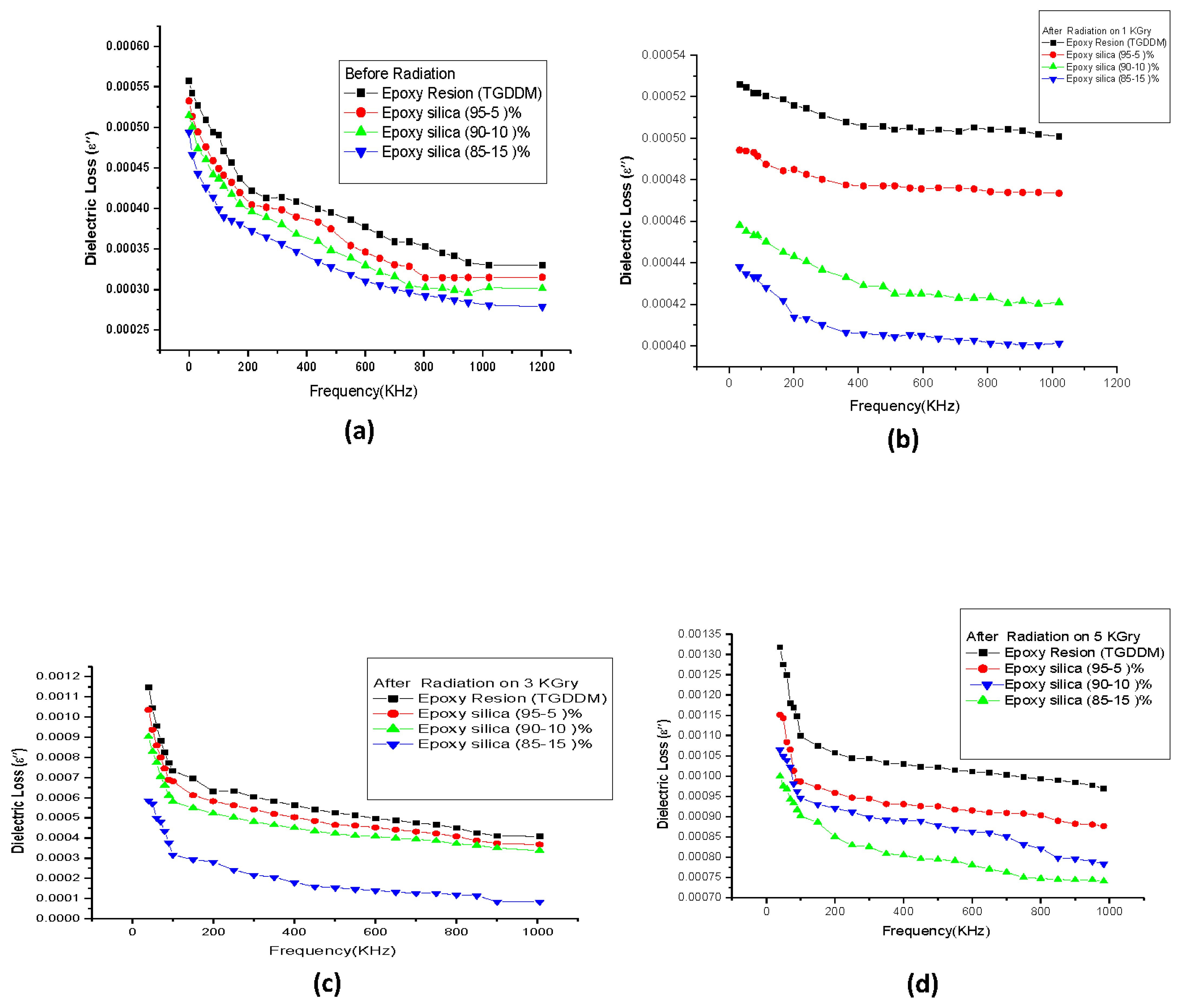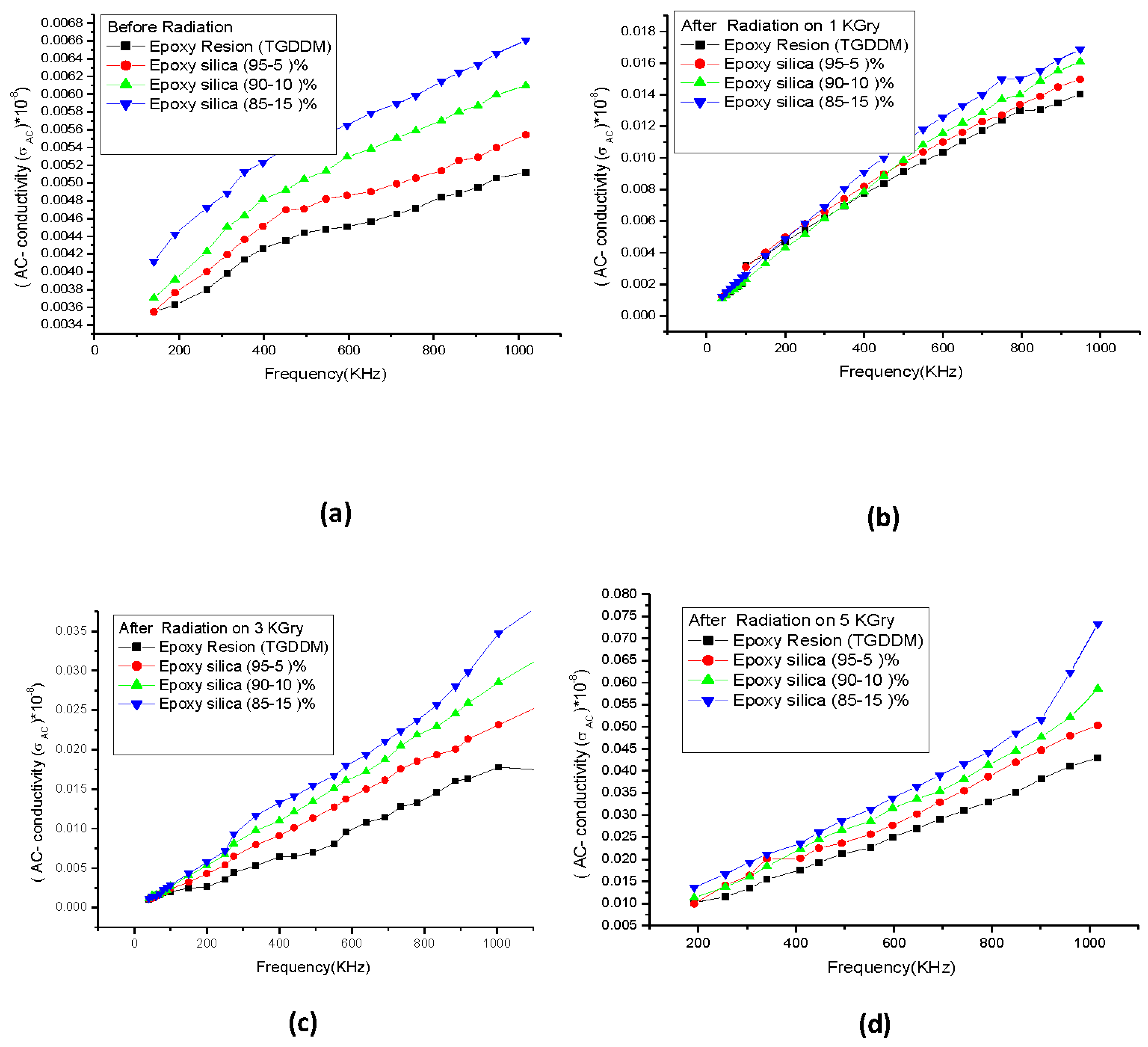Effects of Gamma Radiation Doses on the AC Electrical Properties of Epoxy Reinforced with Nano-Silica Composites
Abstract
1. Introduction
- -
- Healthcare: Nanocomposites can be used to create new medical devices, such as drug delivery systems and tissue engineering scaffolds. Energy: Nanocomposites can be used to create new energy storage devices, such as batteries and fuel cells.
- -
- Transportation: Nanocomposites can be used to create lighter, stronger, and more fuel-efficient vehicles.
- -
- Construction: Nanocomposites can be used to create stronger, more durable, and more energy-efficient buildings.
- -
- Consumer goods: Nanocomposites can be used to create new and improved consumer goods, such as clothing, electronics, and food packaging.
- In situ polymerization: This method involves polymerizing the polymer in the presence of the nanoparticles.
- Melt blending: This method involves melting the polymer, then adding the nanoparticles to the molten polymer.
- Solution blending: This method involves dissolving the polymer in a solvent and then adding the nanoparticles to the solution. This method was used to prepare epoxy nano-silica composites with different silica concentrations = 0, 5, 10, and 15 wt.%, respectively.
2. Experimental
2.1. Samples Preparation
2.2. Gamma Radiation (γ Radiation)
2.3. AC-Electrical Parameters Calculations
3. Results and Discussion
4. Conclusions
Author Contributions
Funding
Data Availability Statement
Conflicts of Interest
References
- Dolez, P.I. Nanomaterials definitions, classifications, and applications. In Nanoengineering; Elsevier: Amsterdam, The Netherlands, 2015; pp. 3–40. [Google Scholar]
- Mu, Y.; Liang, H.; Hu, J.; Jiang, L.; Wan, L. Controllable Pt Nanoparticle Deposition on Carbon Nanotubes as an Anode Catalyst for Direct Methanol Fuel Cells. J. Phys. Chem. B 2005, 109, 22212–22216. [Google Scholar] [CrossRef] [PubMed]
- Öncel, Ç.; Yürüm, Y. Carbon nanotube synthesis via the catalytic CVD method: A review on the effect of reaction parameters. Fuller. Nanotub. Carbon Nonstructures 2006, 14, 17–37. [Google Scholar] [CrossRef]
- Mou’ad, A.T.; Saraireh, S.A.; Chen, R.S.; Ahmad, S.H.; Al-Tarawni, M.A.; Yu, L.J. Gamma irradiation influence on mechanical, thermal and conductivity properties of hybrid carbon nanotubes/montmorillonite nanocomposites. Radiat. Phys. Chem. 2021, 179, 109168. [Google Scholar]
- Badawy, A.A.; El-Shafey, S.E.; Abd El All, S.; El-Shobaky, G.A. Effect of γ-irradiation and calcination temperature of nanosizedZnO/TiO2 system on its structural and electrical properties. Adv. Chem. 2014, 2014, 301410. [Google Scholar] [CrossRef]
- Anwar, A.; Elfiky, D.; Ramadan, A.M.; Hassan, G.M. Effect of γ-irradiation on the optical and electrical properties of fiber reinforced composites. Radiat. Phys. Chem. 2017, 134, 14–18. [Google Scholar] [CrossRef]
- Parida, S.K. Recent Advances in Polymer-Based Nanocomposites: A Brief Review. Micro Nanosyst. 2022, 14, 121–132. [Google Scholar] [CrossRef]
- Sukesh Babu, M.; Sarathi, R.; Jayantilal Vasa, N.; Imai, T. Investigation on space charge and charge trap characteristics of gamma-irradiated epoxy micro–nano composites. High Volt. 2020, 5, 191–201. [Google Scholar] [CrossRef]
- Abd Allah, A.Q.; Hussain, H.S.; Mohan, K.S. The effect of Gamma radiation on The Dielectric Properties of SiO2\Ep: TiO2\Ep Nanocomposite. Iraqi J. Sci. 2017, 58, 843–847. [Google Scholar]
- Karpagam, R.; Sarathi, R.; Tanaka, T. Understanding the impact of gamma irradiation on electrical and mechanical properties of epoxy nanocomposites. J. Appl. Polym. Sci. 2012, 125, 415–424. [Google Scholar] [CrossRef]
- Ismaiilova, R.S.; Magerramov, A.M.; Kuliev, M.M.; Akhundova, G.A. Electrical Conductivity and Dielectric Permittivity of γ-Irradiated Nanocomposites Based on Ultrahigh-Molecular-Weight Polyethylene Filled with α-SiO2. Surf. Eng. Appl. Electrochem. 2018, 54, 6–11. [Google Scholar] [CrossRef]
- Crăciun, E.; Zaharescu, T.; Jitaru, I.; Ignat, M.; Cătănescu, L.; Zărnescu, G. Radiation behaviour of nanocomposite epoxy material. Univ. Politeh. Buchar. Sci. Bull. Ser. B 2011, 73, 75–86. [Google Scholar]
- Patel, M.; Morrell, P.R.; Murphy, J.J.; Skinner, A.; Maxwell, R.S. Gamma radiation induced effects on silica and on silica–polymer interfacial interactions in filled polysiloxane rubber. Polym. Degrad. Stab. 2006, 91, 406–413. [Google Scholar] [CrossRef]
- Alzúbi, R.; Juwhari, H.; Zihlif, A.; Ragosta, G. Optoelectrical properties of epoxy/silica nanocomposites. Mater. Technol. 2010, 25, 14–18. [Google Scholar] [CrossRef]
- Khan, W.S.; Hamadneh, N.N.; Khan, W.A. Polymer nanocomposites–synthesis techniques, classification and properties. Sci. Appl. Tailored Nanostruct. 2016, 50, 50–67. [Google Scholar]
- Abu Saleh, B.A.; Elimat, Z.M.; Alzubi, R.I.; Juwhari, H.K.; Zihlif, A.M. Ultrafine iron particles/polystyrene composites: Effects of gamma radiation and manufacture aging on the AC electrical characterization. Radiat. Eff. Defects Solids 2022, 177, 1065–1074. [Google Scholar] [CrossRef]
- Singh, V.; Kulkarni, A.R.; Mohan, T.R.R. Dielectric properties of aluminum-epoxy composites. J. Appl. Polym. Sci. 2003, 90, 3602–3608. [Google Scholar] [CrossRef]
- Raghu, S.; Archana, K.; Sharanappa, C.; Ganesh, S.; Devendrappa, H. The physical and chemical properties of gamma ray irradiated polymer electrolyte films. J. Non-Cryst. Solids 2015, 426, 55–62. [Google Scholar]
- Radwan, R.M.; Lotfy, S.; Desouky, O.S. Enhancement of the electrical performance of poly(viny1) alcohol by doping with chlorophyll and gamma irradiation. Nucl. Instr. Meth. Phys. Res. B 2008, 266, 3953–3968. [Google Scholar] [CrossRef]
- More, C.V.; Alsayed, Z.; Badawi, M.S.; Thabet, A.A.; Pawar, P.P. Polymeric composite materials for radiation shielding: A review. Environ. Chem. Lett. 2021, 19, 2057–2090. [Google Scholar] [CrossRef] [PubMed]
- Gao, Y.; Du, B.X. Effect of gamma-ray irradiation on permittivity and dielectric loss of polymer insulating materials. In Proceedings of the 2012 International Conference on High Voltage Engineering and Application, Shanghai, China, 17–20 September 2012; pp. 229–232. [Google Scholar]
- Singh, D.; Singh, N.; Qureshi, A.; Kulriya, P.; Tripathi, A.; Avasthi, D.; Gulluoglu, A.N. Radiation induced modification of dielectric and structural properties of Cu/PMMA polymer composites. J. Non-Cryst. Solids 2010, 356, 856–863. [Google Scholar] [CrossRef]
- Abu Saleh, B.; Ramadin, Y.; Zihlif, A.; Elimat, Z. Optical and electrical properties of polystyrene composites containing ultrafine iron particles. J. Thermoplast. Compos. Mater. 2016, 29, 204–218. [Google Scholar] [CrossRef]
- Elimat, Z.; Saqan, S.; Zihlif, A.; Ragosta, G. AC Electrical Characterization of Epoxy/Whiskers Composites Coated with Titanium Nitride. J. Reinf. Plast. Compos. 2010, 29, 1987–1998. [Google Scholar] [CrossRef]
- Doyan, A. Effects of Gamma Radiation on Electrical Conductivity of PVA-CH Composites. In Materials Science Forum; Trans Tech Publications Ltd.: Bach, Switzerland, 2015; Volume 827, pp. 180–185. [Google Scholar]
- Abu Saleh, B.A. Optical and Electrothermal Properties of Ultrafine Aluminum Particles Dispersed in Poly(Methyl Methacrylate) Polymer. Ph.D. Thesis, The University of Jordan, Amman, Jordan, 2018. [Google Scholar]
- Jonscher, A.K. Dielectric Relaxation in Solids; Chelsea Dielectric Press: London, UK, 1983. [Google Scholar]





| Concentration of Nano-Silica in Composite | n | A (Ω·m)−1 (Hz)−n |
|---|---|---|
| 0% | 0.10 | 8.9 × 10−7 |
| 5% | 0.102 | 1.09 × 10−6 |
| 10% | 0.103 | 1.11 × 10−6 |
| 15% | 0.107 | 1.22 × 10−6 |
| Concentration of Nano-Silica in Composite | n | A (Ω·m)−1 (Hz)−n |
|---|---|---|
| 0% | 0.19 | 2.30 × 10−6 |
| 5% | 0.214 | 2.46 × 10−6 |
| 10% | 0.24 | 2.59 × 10−6 |
| 15% | 0.25 | 2.62 × 10−6 |
| Concentration of Nano-Silica in Composite | n | A (Ω·m)−1 (Hz)−n |
|---|---|---|
| 0% | 0.40 | 4.32 × 10−6 |
| 5% | 0.72 | 4.65 × 10−6 |
| 10% | 0.75 | 5.4 × 10−6 |
| 15% | 0.76 | 2.79 × 10−5 |
| Concentration of Nano-Silica in Composite | n | A (Ω·m)−1 (Hz)−n |
|---|---|---|
| 0% | 0.91 | 5.98 × 10−5 |
| 5% | 0.93 | 6.55 × 10−5 |
| 10% | 0.94 | 7.09 × 10−5 |
| 15% | 0.95 | 7.95 × 10−5 |
Disclaimer/Publisher’s Note: The statements, opinions and data contained in all publications are solely those of the individual author(s) and contributor(s) and not of MDPI and/or the editor(s). MDPI and/or the editor(s) disclaim responsibility for any injury to people or property resulting from any ideas, methods, instructions or products referred to in the content. |
© 2023 by the authors. Licensee MDPI, Basel, Switzerland. This article is an open access article distributed under the terms and conditions of the Creative Commons Attribution (CC BY) license (https://creativecommons.org/licenses/by/4.0/).
Share and Cite
Abusaleh, B.A.; Elimat, Z.M.; Alzubi, R.I.; Juwhari, H.K. Effects of Gamma Radiation Doses on the AC Electrical Properties of Epoxy Reinforced with Nano-Silica Composites. J. Compos. Sci. 2023, 7, 254. https://doi.org/10.3390/jcs7060254
Abusaleh BA, Elimat ZM, Alzubi RI, Juwhari HK. Effects of Gamma Radiation Doses on the AC Electrical Properties of Epoxy Reinforced with Nano-Silica Composites. Journal of Composites Science. 2023; 7(6):254. https://doi.org/10.3390/jcs7060254
Chicago/Turabian StyleAbusaleh, Batool A., Ziad M. Elimat, Ruba I. Alzubi, and Hassan K. Juwhari. 2023. "Effects of Gamma Radiation Doses on the AC Electrical Properties of Epoxy Reinforced with Nano-Silica Composites" Journal of Composites Science 7, no. 6: 254. https://doi.org/10.3390/jcs7060254
APA StyleAbusaleh, B. A., Elimat, Z. M., Alzubi, R. I., & Juwhari, H. K. (2023). Effects of Gamma Radiation Doses on the AC Electrical Properties of Epoxy Reinforced with Nano-Silica Composites. Journal of Composites Science, 7(6), 254. https://doi.org/10.3390/jcs7060254






